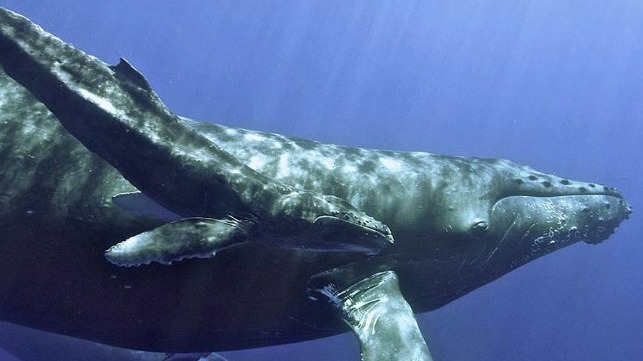How Climate Change is Affecting Humpback Whales in the NW Atlantic

[By Joanna Kershaw]
Climate change is having a serious impact on the world’s oceans in various ways, ranging from its devastating effects on tropical coral reefs to melting polar sea ice. But until now, it wasn’t known how these changes could be affecting whale populations.
Globally, humpback whales are increasing in numbers following the end of commercial whaling, but the populations in the northern hemisphere are not recovering to the same extent as those in the southern hemisphere. Our new research confirms that a North Atlantic population has shown a significant decline in the number of calves over the last 15 years.
The Gulf of St Lawrence in Quebec, Canada, has experienced major environmental changes as a result of warmer water and a dramatic reduction in sea ice. These changes have knock-on effects for the whole ecosystem where fluctuations at the bottom of the food web can result in decreases in the abundance of species higher up, including the prey of baleen whales such as schooling fish like herring and capelin.
Humpback whales need to feed intensively during the summer to build up the energy reserves to sustain them for the rest of the year while they fast. The Gulf of St Lawrence is an important summer feeding ground for humpback whales that migrate between the cold, productive waters of the North Atlantic and the warmer waters of their Caribbean breeding ground every year.
Fewer mothers with calves have been sighted in the Gulf of St Lawrence over the last two decades, so we wanted to investigate if the major environmental changes recorded in the area could be affecting their breeding success.
Mothers and calves
As a team of scientists from the Sea Mammal Research Unit, we worked with colleagues at the Mingan Island Cetacean Study (MICS), an NGO based in Quebec, and the Department of Fisheries and Oceans (DFO) in Canada for this interdisciplinary, long-term study.
We collected small biopsy samples of blubber from adult female humpback whales between 2004 and 2018 to measure reproductive hormones, and effectively carry out a pregnancy test. Colleagues at MICS were able to identify these females from their markings and follow the same individuals over several decades. So every year we knew if they returned to the Gulf of St Lawrence with a calf.
There are only a handful of other whale populations in the world that are studied in such detail. We are the first to combine this long-term information collected over 15 years about their calving rates with pregnancy rates to determine how many pregnancies were successful.
We found that humpback whale pregnancy rates were highly variable over the study period, but 39% of pregnancies were unsuccessful. Annual calving rates declined significantly from approximately 40% to 20% over the 15 years. Working with colleagues at DFO, we gathered information on the annual abundance of their prey as well as data on overall environmental productivity.
Our study confirmed that changes in these environmental data were linked to the decline in calving rates. The probability of observing mother-calf pairs was related to favourable environmental conditions in the previous year, especially with the abundance of herring, one of their main prey. These results suggest that environmental changes in the Gulf of St Lawrence have resulted in declines in herring abundance, and this is negatively affecting the breeding success of the humpback whales.
We believe this decline could – at least in part – be the result of females being unable to build up the energy reserves needed to sustain pregnancy and meet the energetic demands of nourishing their young in years of poorer feeding availability.
Future of baleen whales
It was previously thought that baleen whales could show some resilience to climate change because of their ability to change their migratory patterns, or switch prey species, for example, if the location, timing or abundance of their main prey changed. However, our research shows that their ability to respond in these ways may not be enough to prevent their breeding success from being impacted by environmental change.
Continued monitoring of this humpback population in the Gulf of St Lawrence is required to assess how the observed decline in calving rates will affect population growth and viability.
A study led by researchers at the University of Queensland, Australia, predicted declines in baleen whale populations in the Southern Ocean as a consequence of reduced prey availability such as copedpods and krill, and increasing competition between whale species in response to diminishing food stocks caused by climate change.
Here, together with studies on North Atlantic right whales and Southern Resident killer whales we show that the effects of climate change and environmental variability could be already being felt in northern hemisphere whale populations.
It is possible that other, less-well studied whale populations are also experiencing declines in their breeding success. While it may not be possible to redress the balance in the short term, what we can do now is minimise other potential stressors on these species, particularly human disturbance, and help them to maximise their ability to reproduce successfully.
Joanna Kershaw is a Teaching and Research Associate at Plymouth University.
This article appears courtesy of The Conversation and may be found in its original form here.
The opinions expressed herein are the author's and not necessarily those of The Maritime Executive.

